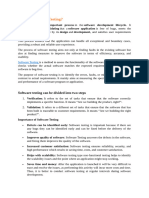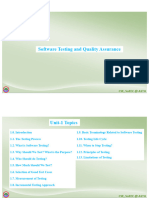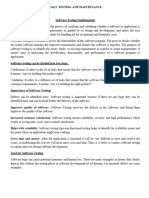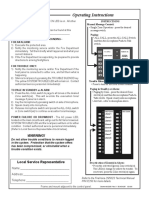0 ratings0% found this document useful (0 votes)
11 viewsSoftware Testing
Uploaded by
abhishek dabralCopyright
© © All Rights Reserved
Available Formats
Download as DOCX, PDF, TXT or read online on Scribd
0 ratings0% found this document useful (0 votes)
11 viewsSoftware Testing
Uploaded by
abhishek dabralCopyright
© © All Rights Reserved
Available Formats
Download as DOCX, PDF, TXT or read online on Scribd
You are on page 1/ 4
What is Software Testing?
The Complete Software Testing
Guide
What is Software Testing?
Software testing is the process of evaluating a
system with the intent of finding bugs. It is
performed to check if the system satisfies its
specified requirements and quality standards. It
evaluates the system to validate its
functionality.
Testing measures the system’s overall quality in terms of
correctness, completeness, usability, performance, and
other functional and non-functional attributes.
Software testing is not associated with uncovering
potential bugs or defects. It also involves finding measures
to improve the system’s efficiency and accuracy.
Basically, software testing is the combination
of verification and validation.
Verification is a static process that does not involve
code execution. It validates the documents, design,
and code against specified requirements and answers
the question – “Are we building the product
right?”.
Validation is a dynamic process that involves code
execution. It checks software for its reliability,
usability, and functionality. It answers the question –
“Are we building the right product?”.
Why is Software Testing Important?
Software Testing is an indispensable activity in SDLC
because it uncovers any bugs or errors early that can be
addressed before releasing the system to the market.
The following are some significant reasons stating the
importance of software testing:
It provides assurance to the stakeholders that the
product works as intended.
Delivering an untested product with avoidable defects
to the end-user/customer leaves a bad reputation for
the development company.
The separate testing phase adds a confidence factor
to the stakeholders regarding the quality of the
software under development.
Defects detected in the earlier phase of SDLC result in
lesser cost and resource utilization for defect
resolution.
The testing team adds another dimension to software
development by providing a different viewpoint to the
product development process.
An untested software not only makes software error-
prone but also costs the customer business failure,
like in the case of Microsoft’s MP3 player – Zune’s
crash.
Software issues can cost lives. E.g., in the case of
Therac 25, many people died due to concurrent
programming errors wherein patients were given
radiation doses that were hundreds of times greater
than normal, resulting in death or serious injury.
Who Conducts Software Testing?
Testing is/can be done by all technical and non-technical
people associated with software development. As testing
is not a single process and a series of phases, the
following are people associated with it in different phases:
Developer – Developers perform unit testing of the
software and ensure that the individual modules or
components work correctly.
Testers – Testers are the face of software testing. A
tester verifies the application’s functionality as a
functional tester, checks its performance as a
performance tester, automates the functional test
cases, and creates test scripts as an automation
tester.
Test Managers/Lead/Architects – They develop
and define the test strategy and test
plan documents.
End Users – A group of end-users does the User
Acceptance Testing (UAT) to ensure the software is ready
to release to the real world.
Levels of Software Testing
There are four levels of software testing, as follows-
Unit Testing: It is the first level of testing that
involves validating every individual component or
module of a software product for its correctness and
functionality. Each module is tested in isolation. It is
usually done by the developers (but some testers,
well-versed with the code, can also write unit tests).
The developers write the code that tests the
individual module or component of the software
application.
Integration Testing: This level involves combining
unit-tested components and testing them as a group.
It uncovers any inconsistencies between the
integration of components.
System Testing: This testing level tests the system
as a whole to ensure it meets quality standards and
specified requirements.
Acceptance Testing: It involves validating the
system for its acceptability by the different
stakeholders or the end users. It serves as the final
stage of testing before the software is released into
production or delivered to the client.
When to Stop Testing?
This question – “When to stop testing” or “How much
testing is enough” is very tricky to answer as we can
never be sure the system is 100% bug-free. But still, some
markers help us in determining the closure of the testing
phase of the software development life cycle.
Sufficient pass percentage – Depending on the
system, testing can be stopped when an agreed-upon
test case pass percentage is reached.
After a successful test case execution – The
testing phase can be stopped when one complete
cycle of test cases is executed after the last known
bug fix.
On meeting deadlines – Testing can be stopped
after deadlines get met with no high-priority issues
left in the system.
Mean Time Between Failure (MTBF) – MTBF is the
time interval between two inherent failures. Based on
the different stakeholder’s decisions, if the MTBF is
large, one can stop the testing.
You might also like
- MRT 2540 Privilege Electrical Schematic Diagrams 80-02-M205EN100% (3)MRT 2540 Privilege Electrical Schematic Diagrams 80-02-M205EN6 pages
- Diploma in Software Testing and Automation: Course SlideNo ratings yetDiploma in Software Testing and Automation: Course Slide1,171 pages
- Software Testing: Department of Computer Science & EngineeringNo ratings yetSoftware Testing: Department of Computer Science & Engineering21 pages
- ST U1L5 (Role of Tester- Testing as a Process)No ratings yetST U1L5 (Role of Tester- Testing as a Process)19 pages
- What Is Software Development Life CycleNo ratings yetWhat Is Software Development Life Cycle119 pages
- The Importance of Software Testing in The Development LifecycleNo ratings yetThe Importance of Software Testing in The Development Lifecycle3 pages
- softwaretestingmethodslevelsandtypes-131226022635-phpapp02No ratings yetsoftwaretestingmethodslevelsandtypes-131226022635-phpapp0244 pages
- 15 Module 5 - Software Testing Methodologies 26-03-2024No ratings yet15 Module 5 - Software Testing Methodologies 26-03-2024141 pages
- Testing Interview Questions and Answers ?No ratings yetTesting Interview Questions and Answers ?32 pages
- Lecture 15 - Introduction To Software Testing-1721286822153No ratings yetLecture 15 - Introduction To Software Testing-172128682215346 pages
- Manual Testing Interview Questions_V1_0No ratings yetManual Testing Interview Questions_V1_0192 pages
- Unit I: Introduction To Software TestingNo ratings yetUnit I: Introduction To Software Testing51 pages
- Quality Assurance Testing from Beginner to Paid Professional, 1: Everything You Need to Know to Start a Career in Manual and Automated QA TestingFrom EverandQuality Assurance Testing from Beginner to Paid Professional, 1: Everything You Need to Know to Start a Career in Manual and Automated QA Testing5/5 (1)
- Software Testing Interview Questions You'll Most Likely Be AskedFrom EverandSoftware Testing Interview Questions You'll Most Likely Be AskedNo ratings yet
- Software Testing: A Guide to Testing Mobile Apps, Websites, and GamesFrom EverandSoftware Testing: A Guide to Testing Mobile Apps, Websites, and Games4.5/5 (3)
- The Nonlinear Behavior of The Transformer InsulationNo ratings yetThe Nonlinear Behavior of The Transformer Insulation5 pages
- Installation Guide PSS®E 35.3.0: July 2021100% (1)Installation Guide PSS®E 35.3.0: July 202116 pages
- Separ Filter SWK-2000 Series: Improves Diesel Engine ReliabilityNo ratings yetSepar Filter SWK-2000 Series: Improves Diesel Engine Reliability2 pages
- Universal Willem EPROM Programmer Quick Start Guide V1.2: 1. InstallationNo ratings yetUniversal Willem EPROM Programmer Quick Start Guide V1.2: 1. Installation8 pages
- What Is A Deepfake?: Furious 7. But It Used To Take Entire Studios Full of Experts A Year To CreateNo ratings yetWhat Is A Deepfake?: Furious 7. But It Used To Take Entire Studios Full of Experts A Year To Create2 pages
- User-Manual GEN3-series-Microinverter MS800MS400 V1.1 230213No ratings yetUser-Manual GEN3-series-Microinverter MS800MS400 V1.1 23021329 pages
- MyFerrari - Ferrari F8 Tributo - Fn61uFCNo ratings yetMyFerrari - Ferrari F8 Tributo - Fn61uFC11 pages
- Service Description: 3. Procedure For ApplyingNo ratings yetService Description: 3. Procedure For Applying18 pages
- Fire Voice 25-50 Instrucciones de OperaciónNo ratings yetFire Voice 25-50 Instrucciones de Operación1 page
- CewePrometer Product Presentation A0151e-10No ratings yetCewePrometer Product Presentation A0151e-1012 pages
- Excel, One Page, For B2C E-Shops, ZIP 12-02-2017 07-14No ratings yetExcel, One Page, For B2C E-Shops, ZIP 12-02-2017 07-14275 pages
- MRT 2540 Privilege Electrical Schematic Diagrams 80-02-M205ENMRT 2540 Privilege Electrical Schematic Diagrams 80-02-M205EN
- ISTQB Certified Tester Foundation Level Practice Exam QuestionsFrom EverandISTQB Certified Tester Foundation Level Practice Exam Questions
- Diploma in Software Testing and Automation: Course SlideDiploma in Software Testing and Automation: Course Slide
- Software Testing: Department of Computer Science & EngineeringSoftware Testing: Department of Computer Science & Engineering
- The Importance of Software Testing in The Development LifecycleThe Importance of Software Testing in The Development Lifecycle
- softwaretestingmethodslevelsandtypes-131226022635-phpapp02softwaretestingmethodslevelsandtypes-131226022635-phpapp02
- 15 Module 5 - Software Testing Methodologies 26-03-202415 Module 5 - Software Testing Methodologies 26-03-2024
- Lecture 15 - Introduction To Software Testing-1721286822153Lecture 15 - Introduction To Software Testing-1721286822153
- Quality Assurance Testing from Beginner to Paid Professional, 1: Everything You Need to Know to Start a Career in Manual and Automated QA TestingFrom EverandQuality Assurance Testing from Beginner to Paid Professional, 1: Everything You Need to Know to Start a Career in Manual and Automated QA Testing
- Software Testing Interview Questions You'll Most Likely Be AskedFrom EverandSoftware Testing Interview Questions You'll Most Likely Be Asked
- Software Testing: A Guide to Testing Mobile Apps, Websites, and GamesFrom EverandSoftware Testing: A Guide to Testing Mobile Apps, Websites, and Games
- The Nonlinear Behavior of The Transformer InsulationThe Nonlinear Behavior of The Transformer Insulation
- Separ Filter SWK-2000 Series: Improves Diesel Engine ReliabilitySepar Filter SWK-2000 Series: Improves Diesel Engine Reliability
- Universal Willem EPROM Programmer Quick Start Guide V1.2: 1. InstallationUniversal Willem EPROM Programmer Quick Start Guide V1.2: 1. Installation
- What Is A Deepfake?: Furious 7. But It Used To Take Entire Studios Full of Experts A Year To CreateWhat Is A Deepfake?: Furious 7. But It Used To Take Entire Studios Full of Experts A Year To Create
- User-Manual GEN3-series-Microinverter MS800MS400 V1.1 230213User-Manual GEN3-series-Microinverter MS800MS400 V1.1 230213
- Excel, One Page, For B2C E-Shops, ZIP 12-02-2017 07-14Excel, One Page, For B2C E-Shops, ZIP 12-02-2017 07-14

























































































